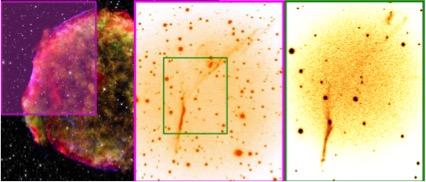Astronomers use IAC instrument to probe the origins of cosmic rays

Left. Composite image of the remnant of Tycho Brahe's supernova (1572) using data from the Chandra x-ray satellite observatory (yellow, green, blue (credits NASA/SAO), from the Spitzer infrared satellite observatory (red, credits, NASA/JPL-Caltech), and from the Calar Alto observatory (stars whtie, credit, Krause et al.). The transparent magenta box shows the field of the ACAM instrument at the Cassegrain focus of the William Herschel Telescope (WHT, ORM, La Palma). Centre, a zoom-in on the ACAM field with a green box showing the size of the field of the 2d spectrograph GHaFaS (WHT, ORM).Right. The reduced and integrated image of GHaFaS in the emission from ionized hydrogen (Ha). Credit: NASA/SAO, NASA/JPL-Caltech
In November 1572 a supernova explosion was observed in the direction of the constellation of Cassiopeia, and its most famous observer was Tycho Brahe, one of the founders of modern observational astronomy.
The explosion produced an expanding cloud of superhot gas, a supernova remnant which was rediscovered in 1952 by British radioastronomers, confirmed by visible photographs from Mount Palomar observatory, California, in the 1960's, and a spectacular image was taken in X-rays by the Chandra satellite observatory in 2002 (see accompanying image). Astronomers use supernova remnants to explore high energy physics in interstellar space.
In an article to be published in the Astrophysical Journal a team from 7 countries, including researchers at the Instituto de Astrofísica de Canarias (IAC), has observed the Tycho supernova remnant with GHaFaS, a sophisticated instrument from the IAC, mounted on the 4.2m William Herschel Telescope (WHT) at the Roque de los Muchachos Observatory (Garafía, La Palma, Canary Islands).
Their aim was to explore the hypothesis that the cosmic rays, high energy sub-atomic particles which continually bombard the Earth's outer atmosphere, originate in these highly energetic gas clouds. GHaFaS allows astronomers to observe the emission from ionized hydrogen across wide fields, giving a map of the velocity structure within an object in fine detail.
They mapped a sizeable portion of the Tycho remnant cloud, including a prominent bright filament, and showed that the hydrogen line emitted from the filament shows a much bigger spread of velocities than can be explained from the temperature of the gas. In fact they measured two components of emission, one with a large velocity spread, and another with an even larger spread.
They showed that the only way for the emission to show these characteristics is if there is a mechanical mechanism in the cloud producing high energy particles. Supernova remnants have long been considered a probable source of the cosmic rays which pour onto the outer atmosphere of the Earth, but this is the first time that clear evidence for an acceleration mechanism has been produced.
Cosmic rays have energies much higher than those produced in even the biggest particle accelerators on Earth (such as CERN), and their study is important not only for astrophysics but for particle physics.
“These results could not have been produced by any of the other spectrographs on major telescopes in the world” says Joan Font, one of the authors of the article, and the person responsible for the operations of GHaFaS. “Our instrument has a unique combination of high velocity resolution, wide field, and good angular resolution, and this combination was required for the Tycho project”.
These observations are a first step towards a fuller understanding of the cosmic ray acceleration mechanism in supernova remnants. “We should be able to combine these results with observations already taken using the OSIRIS narrow band imager on the 10.4m Gran Telescopio CANARIAS (GTC) to determine the efficiency of acceleration of the cosmic rays” says John Beckman, another IAC researcher and a co-author on the paper.
###
Article: “Balmer filaments in Tycho's supernova remnant: an interplay between cosmic-ray and broad-neutral precursors”. Sladjana Kneevi et al 2017 ApJ 846 167
https:/
Contact:
Joan Font: jfont@iac.es
John Beckman: jeb@iac.es
Media Contact
All latest news from the category: Physics and Astronomy
This area deals with the fundamental laws and building blocks of nature and how they interact, the properties and the behavior of matter, and research into space and time and their structures.
innovations-report provides in-depth reports and articles on subjects such as astrophysics, laser technologies, nuclear, quantum, particle and solid-state physics, nanotechnologies, planetary research and findings (Mars, Venus) and developments related to the Hubble Telescope.
Newest articles

NASA: Mystery of life’s handedness deepens
The mystery of why life uses molecules with specific orientations has deepened with a NASA-funded discovery that RNA — a key molecule thought to have potentially held the instructions for…

What are the effects of historic lithium mining on water quality?
Study reveals low levels of common contaminants but high levels of other elements in waters associated with an abandoned lithium mine. Lithium ore and mining waste from a historic lithium…

Quantum-inspired design boosts efficiency of heat-to-electricity conversion
Rice engineers take unconventional route to improving thermophotovoltaic systems. Researchers at Rice University have found a new way to improve a key element of thermophotovoltaic (TPV) systems, which convert heat…



